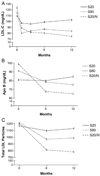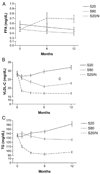Atheroprotective lipoprotein effects of a niacin-simvastatin combination compared to low- and high-dose simvastatin monotherapy
- PMID: 19332196
- PMCID: PMC3088112
- DOI: 10.1016/j.ahj.2009.01.001
Atheroprotective lipoprotein effects of a niacin-simvastatin combination compared to low- and high-dose simvastatin monotherapy
Abstract
Background: Niacin has multiple lipoprotein effects that may provide cardiovascular benefit when added to statin monotherapy.
Methods: In this randomized, placebo-controlled trial (n = 75) of magnetic resonance imaging of carotid atherosclerosis, we performed a secondary comparison of combination niacin-statin (simvastatin 20 mg/Niacin-ER 2G [S20/N]) to monotherapy with moderate (20 mg [S20]) and high-dose (80 mg [S80]) simvastatin on lipids, apolipoproteins (apo), low density lipoprotein (LDL) and high density lipoprotein (HDL) particle subclasses, and inflammatory markers.
Results: At baseline, average age was 71, 72% were male, 62.5% used statins, and average LDL-cholesterol was 111 mg/dL. At 12 months, S20/N, compared to S80, significantly reduced apoB (-36.6% vs -11.9%; P = .05) and lipoprotein(a) (-18% vs +3.5%; P = .001) and had at least an equivalent effect on LDL-cholesterol (-39.3% vs -24.3%; P = .24). The combination reduced the proportion of subjects with atherogenic LDL pattern-B (50% to 11.5%) compared to S80 (56% to 56%) (P = .01). Despite increases in plasma free fatty acids (+62.4%; F = 5.65, P = .005 vs S20 and S80), plasma triglycerides (-29.4%; F = 6.88, P = .002 vs S20 and S80), and very-low-density lipoprotein (-44.2%; F = 7.94, P < .001 vs S20 and S80), levels were reduced by S20/N. S20/N increased HDL-cholesterol levels (+18.1%) as compared to S20 (0%) and S80 (+5.9%) (P < .001 vs both statin arms), largely due to an increase in HDL particle size (+4.6%; P = .01 vs both statin arms).
Conclusions: We demonstrate that full-dose niacin/moderate-dose simvastatin combination has sustained benefits on atherogenic apoB lipoproteins, at least comparable to high-dose simvastatin, while also raising HDL-cholesterol. Results of large clinical trials will inform whether niacin-statin combinations reduce cardiovascular disease events.
Figures


Similar articles
-
The role of niacin in raising high-density lipoprotein cholesterol to reduce cardiovascular events in patients with atherosclerotic cardiovascular disease and optimally treated low-density lipoprotein cholesterol: baseline characteristics of study participants. The Atherothrombosis Intervention in Metabolic syndrome with low HDL/high triglycerides: impact on Global Health outcomes (AIM-HIGH) trial.Am Heart J. 2011 Mar;161(3):538-43. doi: 10.1016/j.ahj.2010.12.007. Epub 2011 Feb 2. Am Heart J. 2011. PMID: 21392609 Free PMC article. Clinical Trial.
-
Targeting low HDL-cholesterol to decrease residual cardiovascular risk in the managed care setting.J Manag Care Pharm. 2008 Oct;14(8 Suppl):S3-28; quiz S30-1. doi: 10.18553/jmcp.2008.14.S8-A.1. J Manag Care Pharm. 2008. PMID: 19891279 Free PMC article. Review.
-
Comparison of once-daily, niacin extended-release/lovastatin with standard doses of atorvastatin and simvastatin (the ADvicor Versus Other Cholesterol-Modulating Agents Trial Evaluation [ADVOCATE]).Am J Cardiol. 2003 Mar 15;91(6):667-72. doi: 10.1016/s0002-9149(03)00007-9. Am J Cardiol. 2003. PMID: 12633795 Clinical Trial.
-
Effect of Switching From Statin Monotherapy to Ezetimibe/Simvastatin Combination Therapy Compared With Other Intensified Lipid-Lowering Strategies on Lipoprotein Subclasses in Diabetic Patients With Symptomatic Cardiovascular Disease.J Am Heart Assoc. 2015 Oct 20;4(10):e001675. doi: 10.1161/JAHA.114.001675. J Am Heart Assoc. 2015. PMID: 26486166 Free PMC article. Clinical Trial.
-
The therapeutic role of niacin in dyslipidemia management.J Cardiovasc Pharmacol Ther. 2014 Mar;19(2):141-58. doi: 10.1177/1074248413514481. Epub 2013 Dec 20. J Cardiovasc Pharmacol Ther. 2014. PMID: 24363242 Review.
Cited by
-
Acipimox, an inhibitor of lipolysis, attenuates atherogenesis in LDLR-null mice treated with HIV protease inhibitor ritonavir.Arterioscler Thromb Vasc Biol. 2009 Dec;29(12):2028-32. doi: 10.1161/ATVBAHA.109.191304. Epub 2009 Sep 17. Arterioscler Thromb Vasc Biol. 2009. PMID: 19762785 Free PMC article.
-
Do We Know When and How to Lower Lipoprotein(a)?Curr Treat Options Cardiovasc Med. 2010 Aug;12(4):396-407. doi: 10.1007/s11936-010-0077-6. Curr Treat Options Cardiovasc Med. 2010. PMID: 20842562
-
Increasing spatial resolution of 3T MRI scanning improves reproducibility of carotid arterial wall dimension measurements.MAGMA. 2014 Jun;27(3):219-26. doi: 10.1007/s10334-013-0407-2. Epub 2013 Sep 18. MAGMA. 2014. PMID: 24046072
-
Therapeutic options to further lower C-reactive protein for patients on statin treatment.Curr Atheroscler Rep. 2010 Jan;12(1):34-42. doi: 10.1007/s11883-009-0075-x. Curr Atheroscler Rep. 2010. PMID: 20425269 Review.
-
Niacin Therapy Increases High-Density Lipoprotein Particles and Total Cholesterol Efflux Capacity But Not ABCA1-Specific Cholesterol Efflux in Statin-Treated Subjects.Arterioscler Thromb Vasc Biol. 2016 Feb;36(2):404-11. doi: 10.1161/ATVBAHA.115.306268. Epub 2015 Dec 17. Arterioscler Thromb Vasc Biol. 2016. PMID: 26681752 Free PMC article. Clinical Trial.
References
-
- Executive Summary of the Third Report of the National Cholesterol Education Program (NCEP) Expert Panel on Detection, Evaluation, and Treatment of High Blood Cholesterol in Adults (Adult Treatment Panel III) JAMA. 2001;285:2486–2497. - PubMed
-
- Grundy SM, Cleeman JI, Merz CN, et al. Implications of recent clinical trials for the National Cholesterol Education Program Adult Treatment Panel III guidelines. Circulation. 2004;110:227–239. - PubMed
-
- Gordon DJ, Probstfield JL, Garrison RJ, et al. High-density lipoprotein cholesterol and cardiovascular disease. Four prospective American studies. Circulation. 1989;79:8–15. - PubMed
-
- Barter PJ, Caulfield M, Eriksson M, et al. Effects of torcetrapib in patients at high risk for coronary events. N Engl J Med. 2007 - PubMed
-
- Tunaru S, Kero J, Schaub A, et al. PUMA-G and HM74 are receptors for nicotinic acid and mediate its anti-lipolytic effect. Nat Med. 2003;9:352–355. - PubMed
Publication types
MeSH terms
Substances
Grants and funding
LinkOut - more resources
Full Text Sources
Medical
Miscellaneous

